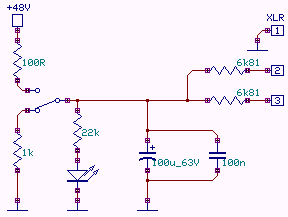[quote author="alk509"]I honestly haven't tried feeding an LED off a phantom supply, but I've read in these fora that you can actually hear the LED distorting the mic signal when you do that. Maybe bullshit, maybe not...[/quote]
Do you happen to have a link to the relevant thread(s) ? I've searched, but none of my keywords have produced anything useful.
There might be a slight amount of AM-detection of CM input signals when phantom is off... but you'd need to have a very hot CM signal plus a mic pre with lousy CMRR to 'hear' any of that (like when your next door neighbour is KRAP-AM). But I might be completely off-base, so I'd like to see arguments/experiences to the contrary.
FWIW, this is what I usually use for phantom switching:
The +48V line has a current limited series transistor regulator per channel. I have never heard birdies with the phantom on or off, but maybe I just haven't found the right high-EMI environment yet.
JDB
[then again, I do most of my recording within less than 7 kilometers of Schiphol Amsterdam Airport, right under one of their busiest flight paths. On the RF stuff I design for work I regularly see nice noise peaks from ATC radar]
